通过Chrome浏览器进行android调试/Remote Debugging on Android with Chrome
The way your web content behaves on mobile can be dramatically different from the desktop experience. Remote debugging with Chrome DevTools lets you
debug live content on your Android device from your development machine.
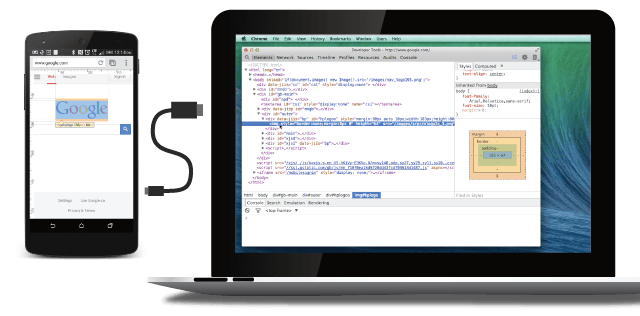
Remote debugging on Android supports:
- Debugging websites in browser tabs.
- Debugging WebViews in native Android apps.
- Screencasting live to your development machine from your Android device.
- Accessing your development server on Android using port forwarding and virtual host mapping.
Requirements
To begin remote debugging, you need:
- Chrome 32 or later installed on your development machine.
- A USB cable to connect your Android device.
- For browser debugging: Android 4.0+ and Chrome for Android.
- For app debugging: Android 4.4+ and a WebView configured for debugging.
Note: Remote debugging requires your version of desktop Chrome to be newer than the version of Chrome for Android on your device.
For best results, use Chrome Canary(Mac/Windows) or the Chrome Dev channel release (Linux) on desktop.
If at any time you encounter problems with remote debugging, refer to the Troubleshooting section.
Setting up your Android device
Follow these instructions to set up your Android device for remote debugging.
1. Enable USB debugging
On your Android device, select Settings > Developer options.
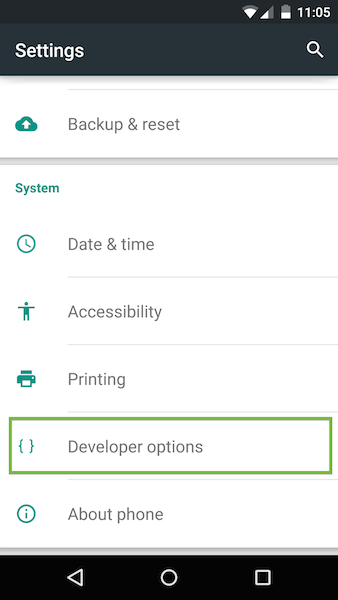
Developer options on the Settings page.
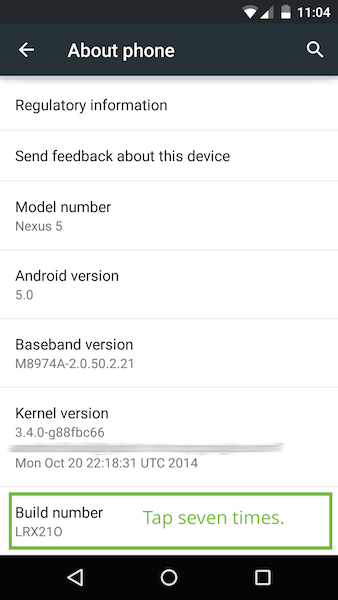
In Developer options, select the USB debugging checkbox:

Enabling USB debugging on Android.
An alert prompts you to allow USB debugging. Tap OK.

2. Connect your device
Connect the Android device to your development machine using a USB cable.
Note: If you are developing on Windows, install the appropriate USB driver for your device.
See OEM USB Drivers on the Android Developers' site.
Discovering devices in Chrome
After setting up remote debugging on Android, discover your device in Chrome.
On your desktop Chrome browser, navigate to chrome://inspect. Confirm that Discover USB devices is checked:
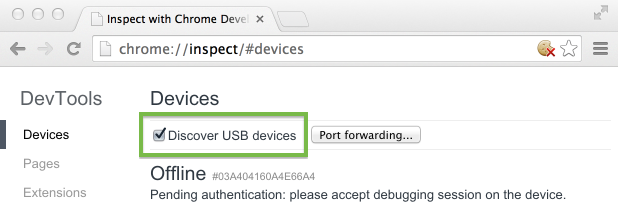
Tip: You can also get to chrome://inspect by selecting Chrome menu > More tools > Inspect Devices.
On your device, an alert prompts you to allow USB debugging from your computer. Tap OK.
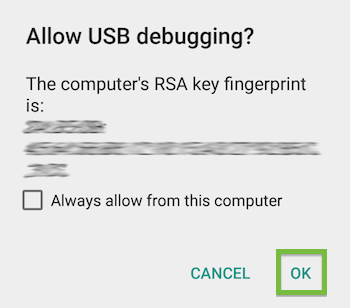
Tip: To skip this alert in the future, check Always allow from this computer.
The message USB debugging connected displays in the device's notification drawer.
Note: During remote debugging, Chrome prevents your device’s screen from going to sleep. This feature is useful for debugging, but is also less secure.
So be sure to keep an eye on your device!
On your computer, the chrome://inspect page displays every connected device, along with its open tabs and debug-enabled WebViews.

Viewing connected devices from the chrome://inspect page.
If you have problems finding your device on the chrome://inspect page, see the Troubleshooting section.
Debugging remote browser tabs
From the chrome://inspect page, you can launch DevTools and debug your remote browser tabs.
To start debugging, click inspect below the browser tab you want to debug.
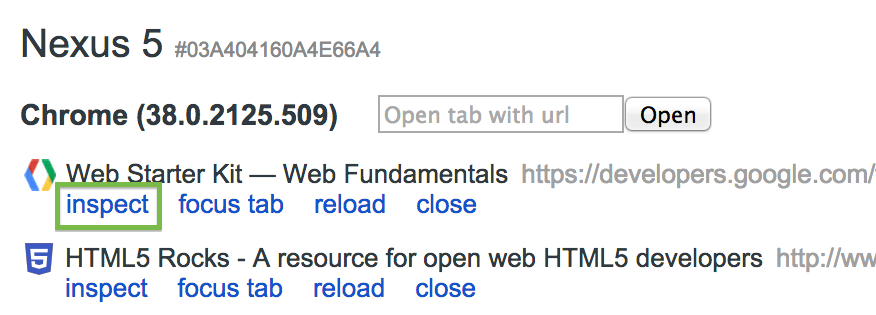
A new instance of Chrome DevTools launches on your computer. From this instance, you can interact with the selected browser tab on your device in real time.
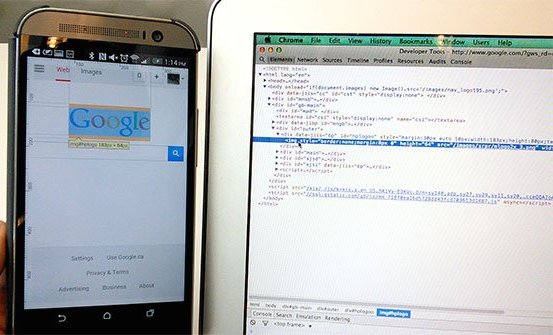
Debug a web page on your Android phone from your laptop using Chrome DevTools.
For example, you can use DevTools to inspect web page elements on your device:
- When you mouse over an element in the Elements panel, DevTools highlights the element on your device.
- You can also click the Inspect Element
 icon in DevTools and tap your device screen. DevTools highlights the tapped element in the Elements panel.
icon in DevTools and tap your device screen. DevTools highlights the tapped element in the Elements panel.
Note: The version of Chrome on your device determines the version of DevTools used during remote debugging. For this reason,
the remote debugging DevTools might differ from the version that you normally use.
Debugging tips
Here are a few tips to help get you started with remote debugging:
- Use F5 (or Cmd+r on Mac) to reload a remote page from the DevTools window.
- Keep the device on a cellular network. Use the Network panel to view the network waterfall under actual mobile conditions.
- Use the Timeline panel to analyze rendering and CPU usage. Hardware on mobile devices often runs much slower than on your development machine.
- If you’re running a local web server, use port forwarding or virtual host mapping to access the site on your device.
Debugging WebViews
On Android 4.4 (KitKat) or later, you can use DevTools to debug WebView content in native Android applications.
Configure WebViews for debugging
WebView debugging must be enabled from within your application. To enable WebView debugging, call the static method setWebContentsDebuggingEnabled
on the WebView class.
if (Build.VERSION.SDK_INT >= Build.VERSION_CODES.KITKAT) {
WebView.setWebContentsDebuggingEnabled(true);
}
This setting applies to all of the application's WebViews.
Tip: WebView debugging is not affected by the state of the debuggable flag in the application's manifest. If you want to enable WebView debugging only when debuggable is true,
test the flag at runtime.
if (Build.VERSION.SDK_INT >= Build.VERSION_CODES.KITKAT) {
if (0 != (getApplicationInfo().flags &= ApplicationInfo.FLAG_DEBUGGABLE))
{ WebView.setWebContentsDebuggingEnabled(true); }
}
Open a WebView in DevTools
The chrome://inspect page displays a list of debug-enabled WebViews on your device.
To start debugging, click inspect below the WebView you want to debug. Use DevTools as you would for a remote browser tab.

Debugging a remote Android WebView with the Chrome DevTools.
The gray graphics listed with the WebView represent its size and position relative to the device's screen. If your WebViews have titles set, the titles are listed as well.
Live screencasting
Shifting your attention between screens isn’t always convenient. Screencast displays your device's screen right alongside DevTools on your development machine. You can interact with the content on your device from the screencast too.
As of KitKat 4.4.3, screencast is available for both browser tabs and Android WebViews.
Start a screencast session
To start screencasting, click the Screencast  icon in the upper right corner of your remote debugging DevTools window.
icon in the upper right corner of your remote debugging DevTools window.

The Screencast icon.
The Screencast panel opens on the left and displays a live view of your device's screen.
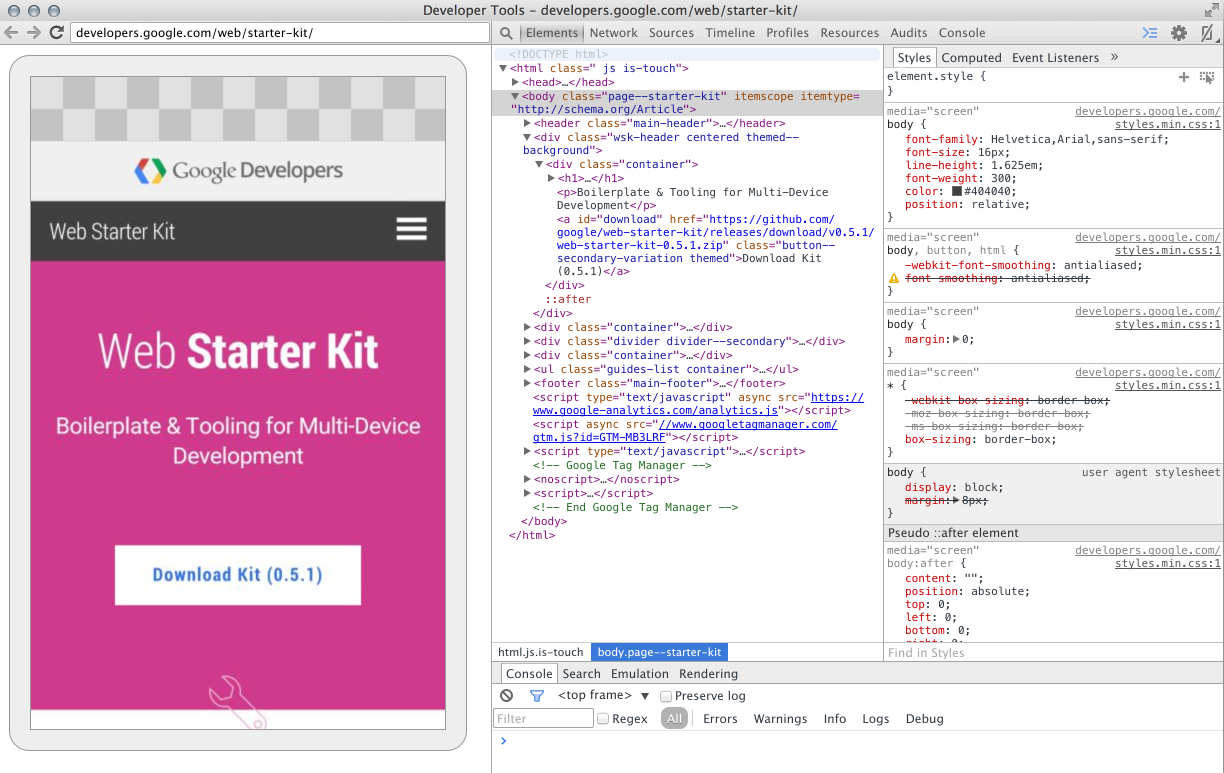
Live interactive screencast from your Android to your laptop.
Screencast only displays page content. Transparent portions of the screencast are covered by the omnibox, device keyboard, and other device interfaces.
Note: Because screencast continuously captures frames, it has some performance overhead. If your tests are sensitive to frame rate, disable screencast.
Interact with your device using the screencast
When you interact with the screencast, clicks are translated into taps, firing proper touch events on the device. Keystrokes from your computer are sent to the device, so you can avoid typing with your thumbs.
Other DevTools work with the screencast too. For example, to inspect an element, click the Inspect Element  icon and then click inside the screencast.
icon and then click inside the screencast.
Tips: To simulate a pinch gesture, hold Shift while dragging. To scroll, use your trackpad or mouse wheel or fling with your pointer.
Port forwarding
Your phone can't always reach the content on your development server. They might be on different networks. Moreover, you might be developing on a restricted corporate network.
Port forwarding on Chrome for Android makes it easy to test your development site on mobile. It works by creating a listening TCP port on your mobile device that maps to a particular TCP port on your development machine. Traffic between these ports travels through USB, so the connection doesn't depend on your network configuration.
To enable port forwarding:
- Open chrome://inspect on your development machine.
- Click Port Forwarding. The port forwarding settings display.
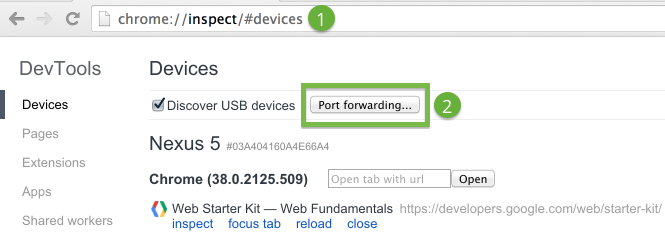
- In the Device port field, enter the port number you want your Android device to listen on.
(The default port is 8080.) - In the Host field, enter the IP address (or hostname) and port number where your web application is running.
This address can be any local location accessible from your development machine. Currently, port numbers must be between 1024 and 32767 (inclusive). - Check Enable port forwarding.
- Click Done.
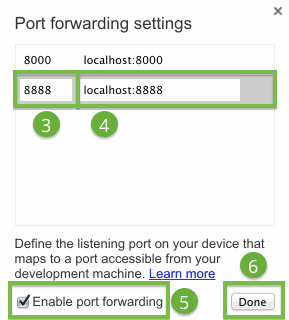 The port forwarding settings.
The port forwarding settings.
The port status indicators on chrome://inspect are green when port forwarding is successful.
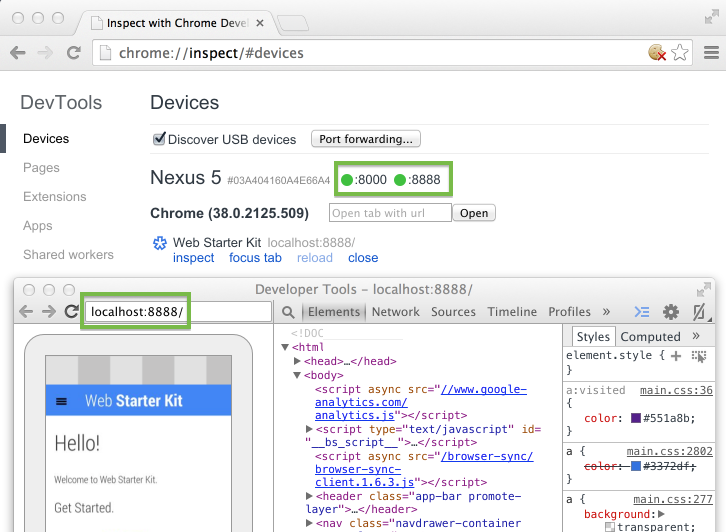
Viewing the content of your local web server on Android using port forwarding.
Now you can open a new Chrome for Android tab and view the content of your local server on your device.
Virtual host mapping
Port forwarding works great when you're developing on localhost. But there are cases when you might be using a customized local domain.
For example, suppose you're using a third party JavaScript SDK that only works on whitelisted domains. So you added an entry, such as 127.0.0.1 production.com, to your hosts file. Or maybe you configured a customized domain using virtual hosts on your web server (MAMP).
If you want your phone to reach content on your customized domain, you can use port forwarding in combination with a proxy server. The proxy maps requests from your device to the correct location on the host machine.
Set up port forwarding to a proxy
Virtual host mapping requires you to run a proxy server on the host machine. All requests from your Android device will be forwarded to the proxy.
To set up port forwarding to a proxy:
- On the host machine, install proxy software such as Charles Proxy (free trial available) or Squid.
- Run the proxy server and note the port that it's using.
Note: The proxy server and your development server must be running on different ports.
- In a Chrome browser, navigate to chrome://inspect.
- Click Port forwarding. The port forwarding settings display.
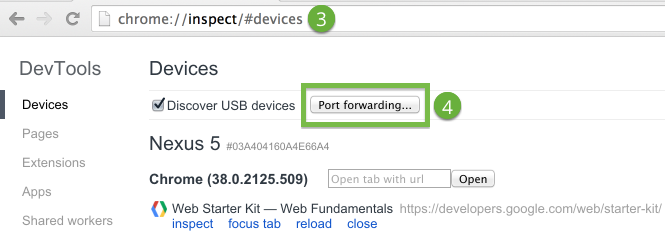
- In the Device port field, enter the port number that you want your Android device to listen on.
Use a port that Android allows, such as9000. - In the Host field, enter
localhost:xxxx, wherexxxxis the port your proxy is running on. - Check Enable port forwarding.
- Click Done.
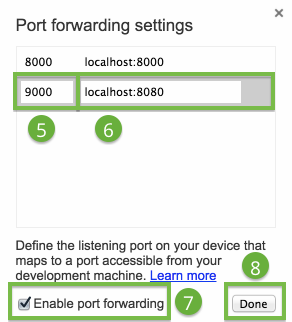 Port forwarding to a proxy.
Port forwarding to a proxy.
The proxy on the host machine is set up to make requests on behalf of your Android device.
Configure proxy settings on your device
Your Android device needs to communicate with the proxy on the host machine.
To configure the proxy settings on your device:
- Select Settings > Wi-Fi.
- Long-press the network that you are currently connected to.
Note: Proxy settings apply per network.
- Tap Modify network.
- Select Advanced options.
The proxy settings display.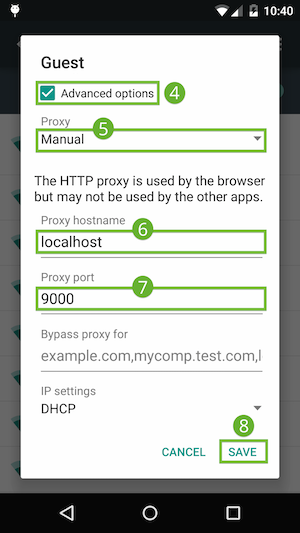 Proxy settings on the device.
Proxy settings on the device. - Tap the Proxy menu and select Manual.
- In the Proxy hostname field, enter
localhost. - In the Proxy port field, enter
9000. - Tap Save.
With these settings, your device forwards all of its requests to the proxy on the host machine. The proxy makes requests on behalf of your device, so requests to your customized local domain are properly resolved.
Now you can load local domains on Chrome for Android just as you would on the host machine.
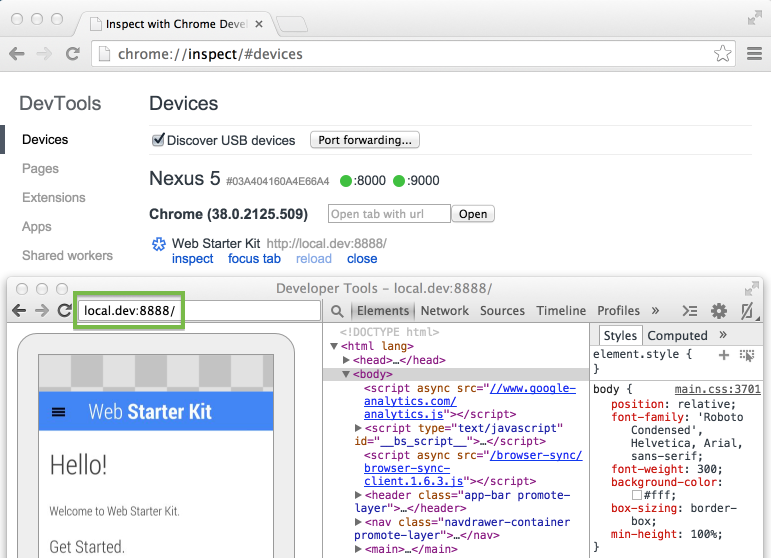
Using virtual host mapping to access a customized local domain from an Android device.
Tip: To resume normal browsing, remember to revert the proxy settings on your device after you disconnect from the host.
Troubleshooting
I can't see my device on the chrome://inspect page.
- If you are developing on Windows, verify that the appropriate USB driver for your device is installed. See OEM USB Drivers on the Android Developers' site.
- Verify that the device is connected directly to your machine, bypassing any hubs.
- Verify that USB debugging is enabled on your device. Remember to accept the USB debugging permission alerts on your device.
- On your desktop browser, navigate to chrome://inspect and verify that Discover USB devices is checked.
- Remote debugging requires your version of desktop Chrome to be newer than the version of Chrome for Android on your device. Try using Chrome Canary (Mac/Windows) or the Chrome Dev channel release (Linux) on desktop.
If you still can't see your device, unplug it. On your device, select Settings > Developer options. Tap Revoke USB debugging authorizations. Then, retry the device setup and discovery processes.
I can't see my browser tabs on the chrome://inspect page.
- On your device, open the Chrome browser and navigate to the web page you want to debug. Then, refresh thechrome://inspect page.
I can't see my WebViews on the chrome://inspect page.
- Verify that WebView debugging is enabled for your app.
- On your device, open the app with the WebView you want to debug. Then, refresh the chrome://inspect page.
I can't access my web server from my Android device.
- If network restrictions prevent your mobile device from accessing your development server, try enabling port forwarding or setting up a virtual host map.
Lastly, if remote debugging still isn't working, you can revert to the legacy workflow using the adb binary from the Android SDK.
Additional information
Remote debugging and ADB
You no longer need to configure ADB or the ADB plugin to debug remote browser tabs and WebViews. Remote debugging for Android is now part of the standard Chrome DevTools. It works on all operating systems: Windows, Mac, Linux, and Chrome OS.
If you do encounter problems with remote debugging, you can try the legacy workflow using the adb binary from the Android SDK.
Note: The direct USB connection between Chrome and the device might interrupt your adbconnection. Before establishing your adb connection, uncheck Discover USB devices onchrome://inspect. Then, disconnect and reconnect the device.
Remote debugging for DevTools extension developers
For information about the remote debugging interaction protocol, refer to the Debugger Protocol documentation andchrome.debugger.
Content available under the CC-By 3.0 license
通过Chrome浏览器进行android调试/Remote Debugging on Android with Chrome的更多相关文章
- 安卓手机移动端Web开发调试之Chrome远程调试(Remote Debugging)
一.让安卓打debug模式的apk包 二.将电脑中的chrome升级到最新版本,在chrome浏览器地址栏中输入chrome://inspect/#devices: 在智能手机还未普及时,移动设备的调 ...
- Android WebView remote debugging
/***************************************************************************** * Android WebView rem ...
- Android/iOS Remote debugging
简单介绍 使用下面方法可以定位webview中的元素,无法定位view中的元素. 原文地址:http://mp.weixin.qq.com/s/y_UfdgjT_pkKgYivJmqt7Q webvi ...
- Chrome浏览器扩展开发系列之二:Google Chrome浏览器扩展的调试
1) 查看扩展程序的详细信息和ID 通过Chrome 浏览器的“ 工具->更多工具->扩展程序”,打开chrome://extensions页面,选中右上角的“开发者模式”,可以 ...
- chrome浏览器的VUE调试插件Vue.js devtools
chrome浏览器的VUE调试插件Vue.js devtools 应用商店直接安装 安装成功后在VUE文件打开可以直接调试: 提示效果如下: F12进入调试状态即可: 安装中出现的问题: 插件安装 ...
- chrome浏览器安装vue调试器vue-devtools
chrome浏览器安装vue调试器vue-devtools https://blog.csdn.net/zhangjnwei/article/details/76693053
- 如何使用chrome浏览器进行js调试找出元素绑定的点击事件
大家有没有遇到这样的一个问题,我们在分析一些大型电子商务平台的Web前端脚本时,想找到一个元素绑定的点击事件,并不是那么容易,因为有些前端脚本封装的比较隐蔽,甚至有些加密脚本,用传统的查找元素ID.或 ...
- Idea进行java应用的远程调试Remote debugging
本文可以解决如下两个问题: 1.如何处理和调试那些只发生在生产环境(或其他远程环境)而本地开发环境可能没办法重现的"问题". 2.只有一个可以部署的war/jar包,只有class ...
- Java环境下 selenium webDriver + chrome浏览器搭建与调试
一.首先下载selenium webDriver jar包,下载地址如下: http://selenium-release.storage.googleapis.com/index.html 二.下载 ...
随机推荐
- emacs 打开文件乱码
emacs在win下写的文件在linux打开乱码 M-x set-language-environment RET chinese-gb 改变当前编码 用当前编码重新打开 M-x rever ...
- WindowManager.LayoutParams 详解
WindowManager.LayoutParams 是 WindowManager 接口的嵌套类:继承于 ViewGroup.LayoutParams .它的内容十分丰富.其实WindowManag ...
- Git以及github的使用方法(五),暂存区和工作区
Git和其他版本控制系统如SVN的一个不同之处就是有暂存区的概念. 先来看名词解释. 工作区(Working Directory) 就是你在电脑里能看到的目录,比如我的learngit文件夹就是一个工 ...
- redis cmd 使用样例
Redis 命令參考 一 Redis介绍 Redis是一个开源的使用ANSI C语言编写.支持网络.可基于内存亦可持久化的日志型.Key-Value数据库,并提供多种语言的API.从2010年3月15 ...
- Nginx(一):安装
nginx 的安装 下载地址: http://nginx.org/download/nginx-1.4.2.tar.gz 安装准备: nginx依赖于pcre库,要先安装pcre(正则的库) yum ...
- 【转载】聊一聊C#的Equals()和GetHashCode()方法
首先先谈一下Equals()这个方法: Equals()方法,来自于Object,是我们经常需要重写的方法.此方法的默认实现大概是这样的: public virtual bool Equals(obj ...
- AsyncTask源代码解析
快要毕业了.近期在阿里巴巴校园招聘面试,一面过了,感觉挺轻松,可能是运气好.面试官感觉比我腼腆一些.我俩从android绕到了spring mvc 到数据库悲观锁 到linux 然后又会到了andro ...
- 笔记04 WPF对象引用
转自:http://www.fx114.net/qa-261-90254.aspx 我们应该都知道,XAML是一种声明式语言,XAML的标签声明的就是对象.一个XAML标签会对应着一个对象,这个对象一 ...
- leetcode第一刷_Symmetric Tree
必须承认,一開始这道题我是不会做的.由于我心目中的树遍历仅仅能用一个节点发起.多么天真而无知. 我想不通如何同一时候遍历两颗子树.由于根节点一定是一个啊.但是,作为对称轴上的它.从一開始就不应该被考虑 ...
- 几篇QEMU/KVM代码分析文章
QEMU/KVM结合起来分析的几篇文章,代码跟最新的版本有些差异,但大体逻辑一样,写得通俗易懂.我把链接放这里主要是为自己需要查看时调转过去方便,感谢作者的付出! QEMU Source Code S ...
